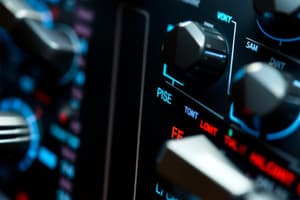Podcast
Questions and Answers
What type of data takes on continuous values?
What type of data takes on continuous values?
- Periodic data
- Composite data
- Analog data (correct)
- Digital data
What is a characteristic of a periodic signal?
What is a characteristic of a periodic signal?
- It completes a pattern within a measurable time frame (correct)
- It changes without exhibiting a pattern or cycle
- It is a type of digital signal
- It can have an infinite number of values in a range
What type of signal can have an infinite number of values in a range?
What type of signal can have an infinite number of values in a range?
- Digital signal
- Nonperiodic signal
- Periodic signal
- Analog signal (correct)
What is a simple periodic analog signal?
What is a simple periodic analog signal?
What type of data is typically used in data communications?
What type of data is typically used in data communications?
What is a characteristic of a nonperiodic signal?
What is a characteristic of a nonperiodic signal?
What is the frequency of a signal that does not change at all?
What is the frequency of a signal that does not change at all?
What is the phase of a sine wave that is offset 1/6 cycle with respect to time 0?
What is the phase of a sine wave that is offset 1/6 cycle with respect to time 0?
What is represented by a single spike in the frequency domain?
What is represented by a single spike in the frequency domain?
What is the result of decomposing a non-periodic composite signal using Fourier analysis?
What is the result of decomposing a non-periodic composite signal using Fourier analysis?
What is the bandwidth of a composite signal?
What is the bandwidth of a composite signal?
Why is a single-frequency sine wave not useful in data communications?
Why is a single-frequency sine wave not useful in data communications?
What is the bandwidth of a periodic signal composed of five sine waves with frequencies of 100, 300, 500, 700, and 900 Hz?
What is the bandwidth of a periodic signal composed of five sine waves with frequencies of 100, 300, 500, 700, and 900 Hz?
What are the lowest and highest frequencies of a nonperiodic composite signal with a bandwidth of 200 kHz and a middle frequency of 140 kHz?
What are the lowest and highest frequencies of a nonperiodic composite signal with a bandwidth of 200 kHz and a middle frequency of 140 kHz?
How many bits are needed to represent each level of a digital signal with eight levels?
How many bits are needed to represent each level of a digital signal with eight levels?
What is the minimum number of signal levels required for a digital signal to transmit 2 bits of information per level?
What is the minimum number of signal levels required for a digital signal to transmit 2 bits of information per level?
How many bits are needed to represent each level of a digital signal with nine levels?
How many bits are needed to represent each level of a digital signal with nine levels?
What is the main difference between analog and digital signals?
What is the main difference between analog and digital signals?
What is the name of the converter that changes digital signals to analog signals and vice versa?
What is the name of the converter that changes digital signals to analog signals and vice versa?
What is signal impairment caused by?
What is signal impairment caused by?
What happens to the signal as it travels through a transmission medium?
What happens to the signal as it travels through a transmission medium?
What is attenuation?
What is attenuation?
What is the effect of a 3 dB loss on a signal's power?
What is the effect of a 3 dB loss on a signal's power?
What happens to the signal's power if it is increased 10 times after passing through an amplifier?
What happens to the signal's power if it is increased 10 times after passing through an amplifier?
Why do engineers use decibels to measure changes in signal strength?
Why do engineers use decibels to measure changes in signal strength?
What is thermal noise caused by?
What is thermal noise caused by?
What is the unit of measurement for the loss in a cable?
What is the unit of measurement for the loss in a cable?
What happens to the signal power when traveling through a cable with a loss of -0.3 dB/km?
What happens to the signal power when traveling through a cable with a loss of -0.3 dB/km?
What is crosstalk?
What is crosstalk?
What is the power of the signal at 5 km if the signal at the beginning of a cable has a power of 2 mW and a loss of -0.3 dB/km?
What is the power of the signal at 5 km if the signal at the beginning of a cable has a power of 2 mW and a loss of -0.3 dB/km?
Flashcards are hidden until you start studying




